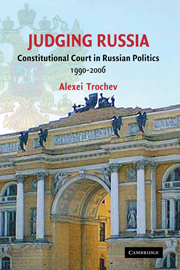Book contents
- Frontmatter
- Contents
- List of Figures and Tables
- Acknowledgments
- Abbreviations
- Notes on Transliteration
- 1 Introduction: Three Puzzles of Postcommunist Judicial Empowerment
- 2 Nonlinear Judicial Empowerment
- 3 Making and Remaking Constitutional Review, Russian-Style
- 4 Russian Constitutional Review in Action (1990–1993)
- 5 Decision Making of the 2nd Russian Constitutional Court: 1995–2006
- 6 The Constitutional Court Has Ruled – What Next?
- 7 The 2nd Russian Constitutional Court (1995–2007): Problematique of Implementation
- 8 “Tinkering with Judicial Tenure” and “Wars of Courts” in Comparative Perspective
- 9 Conclusion: Zigzagging Judicial Power
- Appendix
- Bibliography
- Statutes and Decrees
- Court Decisions
- Index
4 - Russian Constitutional Review in Action (1990–1993)
Published online by Cambridge University Press: 25 July 2009
- Frontmatter
- Contents
- List of Figures and Tables
- Acknowledgments
- Abbreviations
- Notes on Transliteration
- 1 Introduction: Three Puzzles of Postcommunist Judicial Empowerment
- 2 Nonlinear Judicial Empowerment
- 3 Making and Remaking Constitutional Review, Russian-Style
- 4 Russian Constitutional Review in Action (1990–1993)
- 5 Decision Making of the 2nd Russian Constitutional Court: 1995–2006
- 6 The Constitutional Court Has Ruled – What Next?
- 7 The 2nd Russian Constitutional Court (1995–2007): Problematique of Implementation
- 8 “Tinkering with Judicial Tenure” and “Wars of Courts” in Comparative Perspective
- 9 Conclusion: Zigzagging Judicial Power
- Appendix
- Bibliography
- Statutes and Decrees
- Court Decisions
- Index
Summary
Question: So you are trying to stop the people from falling over the precipice?
Answer: That is the main task of the Constitutional Court. The very existence of this body is a guarantee of public security. We should and must protect the borders of the legal ground beyond which lie the abyss, the precipice, perdition.
– Chief Justice of the Russian Constitutional Court Valerii ZorkinThe Constitutional Court should act as a court of law and should not behave as a crew of firefighters or paramedics.
– Russian Constitutional Court Justice Nikolai VitrukThis chapter together with Chapter 5 examines judicial behavior, which is the second element of nonlinear judicial empowerment, as outlined in Chapter 2. Judicial behavior is a key element in the trilateral dynamic of judicial empowerment because the two other elements – design of judicial review and compliance with court decisions – do not exist without the court decisions. A polity could have a judicial review body that is enshrined in the constitution and is issuing decisions in parallel with the widespread nonimplementation of court decisions (the USSR Constitutional Supervision Committee). One could also think of a polity where the court asserts judicial review powers without explicit constitutional authorization (lacking the design of judicial review), exercises judicial review of laws, and compels the government to obey its judgments (U.S. Supreme Court). In both cases, court decisions play an important role.
- Type
- Chapter
- Information
- Judging RussiaThe Role of the Constitutional Court in Russian Politics 1990–2006, pp. 93 - 117Publisher: Cambridge University PressPrint publication year: 2008



